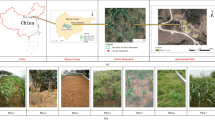Abstract
Quantifying different hydrological components is an initial step for sustainable water resources planning and management. One rising concern is the conflict between the environment, hydropower and agriculture mainly in lowland areas where a large share of the base flows need to be abstracted. The Soil and Water Assessment Tool (SWAT) model was used to understand the hydrological processes of the Upper Awash River Basin with the emphasis on analyzing the different options for surface runoff generation using the Soil Conservation Service (SCS) Curve Number (CN) method. In this study, SWAT was applied incorporating two methods for estimating the retention parameter (S) for the SCS-CN method. The first allowed S to vary with soil profile moisture content (SM method) and the second allowed S to vary with accumulated plant evapotranspiration (PT method). Hydrograph comparison indicated that the PT method was better in simulating peak flows while the SM method was better in simulating the low flows. While the predicted stream flow hydrographs showed an agreement between the two methods, the simulated annual water balance indicated a disagreement in quantifying the different hydrological components. After evapotranspiration, base flow was the dominant component simulated in the SM method whereas surface runoff was the foremost in the PT method simulation. The analysis indicated that care must be taken when selecting an appropriate tool for quantifying hydrologic system to be used for decision making especially for un-gauged catchments where validation of model results is not possible.





Similar content being viewed by others
References
Arnold JG, Sirinivasan R, Muttiah RS, William JR (1998) Large Area Hydrologic Modeling and Assessment. Part 1, Model Development. J of American Water Resour Assoc 34:73–89
Chekol DA (2006) Modeling of Hydrology and Soil Erosion of Upper Awash River Basin. Dissertation, University of Bonn
ECA (1999) Integrated Water Resources: Issues and Options in Selected African Countries. Economic Commission for Africa, FSSD/ENV/044/98/rev.1
ERSDAC (2009) ASTER Global Digital Elevation Model. ERSDAC. http://www.gdem.aster.ersdac.or.jp/index.jsp. Accessed in March 2010
FAO (2002) Major Soils of the World. Land and Water Digital Media Series 19 (CD-ROM). FAO, Rome
FAO (2005) Irrigation in Africa in figures – AQUASTAT Survey 2005. FAO Water Reports 29, Rome
Hawkins RH (1979) Runoff Curve Numbers from Partial Area Watersheds. J of the Irrig and Drain Div 105:375–389
Jacobs JM, Myers DA, Whitfield BM (2003) Improved Rainfall/Runoff Estimates Using Remotely Sensed Soil Moisture. J of the American Water Resour Assoc 39(2):313–324
Kannan N, Santhi C, Williams JR, Arnold JG (2008) Development of a Continuous Soil Moisture Accounting Procedure for Curve Number Methodology and its Behaviour With Different Evapotranspiration Methods. Hydrol Process 22:2114–2121
King KW, Arnold JG, Bingner RL (1999) Comparison of Green-Ampt and Curve Number Methods on Goodwin Creek Watershed Using SWAT. Trans of the American Soc of Agric Eng 42(4):919–925
Lyon SW, Walter MT, Gérard-Marchant P, Steenhuis TS (2004) Using a Topographic Index to Distribute Variable Source Area Runoff Predicted With the SCS-Curve Number Equation. Hydrol Process 18(15):2757–2771
Mishra SK, Sahu RK, Eldho TI, Jain MK (2006) An Improved Ia–S Relation Incorporating Antecedent Moisture in SCS-CN Methodology. Water Resour Manag 20:643–660
Moreda F (1999) Conceptual rainfall-runoff models for different time steps with special consideration for semi-arid and arid catchments. Dissertation, Vrije Universiteit Brussel
Moriasi DN, Arnold JG, Van Liew MW, Bingner RL, Harmel RD, Veith TL (2007) Model Evaluation Guidelines for Systematic Quantification of Accuracy in Watershed Simulations. Trans of the American Soc of Agric and Biol Eng 50(3):885–900
Nash JE, Sutcliffe IV (1970) River Flow Forecasting through Conceptual Models: Part I – A Discussion of Principles. J of Hydrol 10(3):282–290
Neitsch SL, Arnold JG, Kiniry JR, Williams JR (2005) Soil and Water Assessment Tool Theoretical Documentation: version 2005. USDA Agricultural Research Service and Texas. A&M Blackland Research Center, Temple
Ngigi SN, Savenije HHG, Gichuki FN (2008) Hydrological Impacts of Flood Storage and Management on Irrigation Water Abstraction in Upper Ewaso Ng’iro River Basin, Kenya. Water Resour Manage 22:1859–1879
Setegn SG, Srinivasan R, Melesse AM, Dargahi B (2009a) SWAT Model Application and Prediction Uncertainty Analysis in the Lake Tana Basin, Ethiopia. Hydrol Process 24(3):357–367
Setegn SG, Srinivasan R, Dargahi B, Melesse AM (2009b) Spatial Delineation of Soil Erosion Vulnerability in the Lake Tana Basin, Ethiopia. Hydrol Process 23(26):3738–3750
Shi ZH, Chen LD, Fang NF, Qin DF, Cai CF (2009) Research on the SCS–CN Initial Abstraction Ratio Using Rainfall-Runoff Event Analysis in the Three Gorges Area, China. Catena 77:1–7
Shi P, Chen C, Srinivasan R, Zhang X, Cai T, Fang X, Qu S, Chen X, Li Q (2011) Evaluating the SWAT Model for Hydrological Modeling in the Xixian Watershed and a Comparison With the XAJ Model. Water Resour Manage 25:2595–2612
Steenhuis TS, Winchell M, Rossing J, Zollweg JA, Walter MF (1995) SCS Runoff Equation Revisited for Variable-Source Runoff Areas. J of Irrig and Drain Eng 121:234–238
Tessema SM et al (2014) Watershed modeling as a tool for sustainable water resources management: SWAT model application in the Awash River basin, Ethiopia. In: Setegn SG, Donoso MC (eds) Sustainability of Integrated Water Resources Management Water Governance, Climate and Ecohydrology. Springer, Cham (in press)
van Griensven A, Meixner T (2007) A Global and Efficient Multi-Objective Auto-Calibration and Uncertainty Estimation Method for Water Quality Catchment Models. J of Hydroinformatics 9(4):277–291
World Water Assessment Program (2004) National Water Development Report for Ethiopia. United Nations Educational, Scientific, and Cultural Organization. World Water Assessment Program, UN-WATER/WWAP/2006/7
Acknowledgments
The study was supported by the Swedish strategic research program StandUp for Energy. Moreover, we would like to acknowledge financial support from the Swedish International Development Agency (SIDA) Project Number SWE-2011–066.
Author information
Authors and Affiliations
Corresponding author
Rights and permissions
About this article
Cite this article
Tessema, S.M., Lyon, S.W., Setegn, S.G. et al. Effects of Different Retention Parameter Estimation Methods on the Prediction of Surface Runoff Using the SCS Curve Number Method. Water Resour Manage 28, 3241–3254 (2014). https://doi.org/10.1007/s11269-014-0674-3
Received:
Accepted:
Published:
Issue Date:
DOI: https://doi.org/10.1007/s11269-014-0674-3



